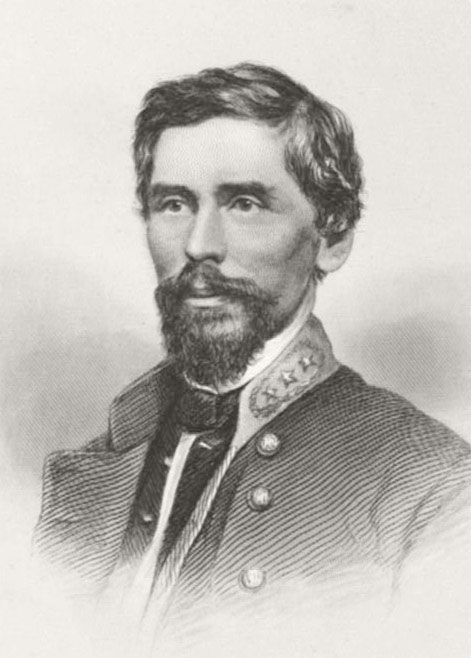The Civil War made widows of thousands of young–and not so young–American women. Thousands more, like Catherine Hewitt, lost their sweethearts before they ever got a chance to marry. One of those unfortunate lovers was Susan Tarleton, a fresh-faced young lady from Mobile, Alabama. Her fiancé, like Hewitt’s, was a major general, but he wore Confederate gray instead of Union blue. His name was Patrick Cleburne.
Pat Cleburne met Susan Tarleton–appropriately enough–at a wedding. In January 1864 his superior officer and best friend, Lt. Gen. William J. Hardee, asked Cleburne to be his best man when he married Mary Lewis Foreman in Demopolis, Ala. Susan Tarleton served as maid of honor in the wedding. The dashing young general and the cultured, artistic, 24-year-old Southern belle hit it off at once. After calling on Miss Tarleton in Mobile following the wedding, Cleburne impulsively asked her to marry him. She hesitated at first, somewhat swept off her feet by the intense, quiet young general. Her brother Robert told another bridesmaid, Sallie Lightfoot: “Poor Sue is like the ‘last rose of summer.’ She needs you to advise her about Genl. C. She is in some perplexity & you know you would be of much assistance to her in it.”
Cleburne returned to the army at Tunnel Hill, Ga., and his staff immediately noticed a difference in the general’s behavior. His adjutant, Captain Irving Buck, wrote to his sister that “Gen. Cleburne says he had a wonderful time. Rumor says he lost his heart with a young lady in Mobile. He has been in a heavenly mood and talks about another leave already.”
With the army secure in its winter quarters, Cleburne managed a 12-day leave in late February. He hastened back to Mobile and his charming young sweetheart. “I took advantage of the lull after the little storm at Dalton to come down and learn my fate from Miss Sue,” Cleburne wrote. “After keeping me in cruel suspense for six weeks she has at length consented to be mine and we are engaged.”
The war, unfortunately, came between Cleburne and Susan Tarleton after they parted in Mobile in early March 1864. They would never see each other again. Like countless other soldiers and their loved ones back home, the couple tried to stay in touch by mail. The previously formal, no-nonsense general revealed another side of his character in his letters to Miss Tarleton. The letters, said aide Leonard Mangum, “were often revelations, even to one who knew him well, as to the depth of his feelings. Devoid of all approach to sentimentality, they were full of a most sweet and tender passion….in every line they were glowing with an affection that was exquisite in its pathos and tenderness.”
The couple hoped to reunite in Georgia that June, but Union General William T. Sherman’s drive on Atlanta prevented the visit. Cleburne put in for another furlough in October, when the couple planned to marry. Once again, the exigencies of war interrupted their plans. Sue Tarleton complained to her friend Sallie Lightfoot: “I received a letter from the Genl which put an end to my writing for the day, and sent me off for a good cry. You must know he had been counting on a furlough for some time and expected to get it about the first of this month. Well! On the 28th when he went to apply, [General John Bell] Hood informed him that the next day his Corps was to move across the Chattahoochee and take such a position in Sherman’s rear as would break up his communications. This puts an end to his visit, and what grieves me more, is but the commencement of another long arduous campaign. I don’t know how I am going to get through it….”
Cleburne and the rest of the Army of Tennessee fell back into their namesake state, hoping as Miss Tarleton said to draw Sherman out of Georgia. Instead, at Franklin, they ran into another Union army already formidably entrenched and waiting for them. In the subsequent disastrous charge, Cleburne and four other Confederate generals were killed, along with 1,750 of their men.
Back home in Mobile, Sue Tarleton waited anxiously for word from–or of–her lover. Union raiding parties had cut all telegraph lines into the city. Six days after the Battle of Franklin, she was walking in her garden when she heard a passing newsboy shout: “Big battle near Franklin, Tennessee! General Cleburne killed! Read all about it.” She fainted dead away.
After spending a year confined to her bedroom in “deepest mourning,” Susan Tarleton reluctantly re-entered the world. In 1867 she married Captain Hugh L. Cole, a former Confederate officer and an old college friend of her brother’s. Less than a year into the marriage, she died unexpectedly of “an effusion of the brain.”
Originally published in the July 1999 issue of America’s Civil War.





